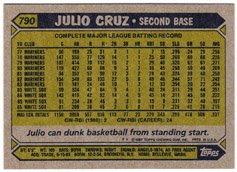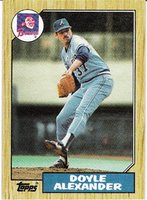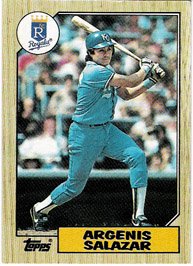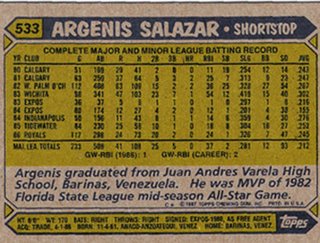 Like the very idea of Clint Courtney’s 1960 card. I mean, the guy’s wearing heavy wire framed eyeglasses, and he’s a catcher. No wonder the Senators were so bad all those years, they were busy rushing their catcher to the emergency room every time he got hit in the face, mask be damned.
Like the very idea of Clint Courtney’s 1960 card. I mean, the guy’s wearing heavy wire framed eyeglasses, and he’s a catcher. No wonder the Senators were so bad all those years, they were busy rushing their catcher to the emergency room every time he got hit in the face, mask be damned.
My all-time favorite card is the 1953 Topps Ed Mathews. I don’t own it because I don’t really have that kind of money to spend on cards these days, (even though it’s been a hallmark of my collecting career to purchase low-grade vintage star cards, just for the pure thrill of owning the card) because if I bought this card, I would want it in as near-perfect condition as humanly possible. This is really the essential card, in my view, and should be considered one of the elite cards of the early Topps sets. Taking nothing away from the enormous appeal of owning the Mantle, Aaron and Koufax rookies from the 1952, 1954 and 1955 sets, respectively, I propose a different take on the holy triptych of early Topps (listed here in chronological order). I would start with Gus Zernial’s 1952 card, the aforementioned Mathews from 1953, and then the Banks rookie in 1954. Actually, here’s my Top 10 best cards (1952-1955):
Taking nothing away from the enormous appeal of owning the Mantle, Aaron and Koufax rookies from the 1952, 1954 and 1955 sets, respectively, I propose a different take on the holy triptych of early Topps (listed here in chronological order). I would start with Gus Zernial’s 1952 card, the aforementioned Mathews from 1953, and then the Banks rookie in 1954. Actually, here’s my Top 10 best cards (1952-1955):
1. Mathews, 1953
2. Banks, 1954
3. Killebrew, 1955
4. Zernial, 1952
5. O’Brien Brothers, 1954
6. Paige, 1953
7. Williams #1, 1954
8. Williams #250, 1954
9. Rhodes, 1955
10. Irvin, 1954; Newhouser, 1955 (tie)
Okay, it’s eleven cards long. And I should probably explain the ranking, but for now I’m not going to, but I do want to talk about the Monte Irvin and Hal Newhouser cards from 1954 & 1955 respectively, because their appeal ties (in a roundabout way) in with another of my favorite cards.
Both Irvin’s and Newhouser’s headshots look like they’re approachable guys, like you could possibly end up in Monte Irvin’s living room listening to jazz records or be invited to a poolside barbeque at the Newhouser residence. They look like the kind of guys who would’ve probably worn turtlenecks and blazers on the team flight if only they played in the Sixties.
So what did they do when they left baseball? Did they open car dealerships or were they out of work homebodies who sat around in the mornings drinking coffee, smoking cigarettes and reading the newspaper at a dingy yet modern, Eames-like kitchen table in their turtlenecks and blazers? I wonder if they collected cards after they were done playing. 
Common sense tells me that probably none of this is true, but it’s one of those romantic visions card collectors sometime escape to when real life is to difficult to fathom. Plus, it would be really cool to grow up having a curmudgeonly old Hal Newhouser or Monte Irvin as your next door neighbor, collecting cards in their spare time, guarded in their personal life but careless enough to leave their doubles lying around where little kids would notice them when they would go over and help take out the garbage or clean the gutters or something. I think that would be cool.
That’s the backstory I’ve given to one of my favorite cards from my collection. It’s a 1971 Topps Willie McCovey (who could’ve been a turtleneck and blazer guy but probably was more of a yellow shirt and fat tie’n’sideburns kind of guy), and it’s a great card. 1971 is one of my favorite designs (right up there with the classic 1954, the thoroughly modern 1959 and the fun 1965 Topps designs), and one of the hardest to find in good condition (those black corners show even the slightest wear, unlike, say, Topps from 1982 and 1983, which you could scuff up the corners and you might be able to pass off as excellent or near-mint).
Of course, keeping with the rest of the vintage cards from my collection, if you had it PSA’d, it would probably get a P – 1, because some guy spilled coffee on it. But here’s the catch (and really what makes it one of my favorites): the spill only covers about one-half of the front of the card, and the card isn’t warped (the back is a little dark from the spill), which probably means the guy caught the spill early. But what about the other cards near it? How did they turn out? I would guess the closer to the epicenter, the more damaged they were. I like to think the card that got burned the most was a Ron Santo (just cause that would be fitting, a nice capstone to a certainly Hall of Fame caliber career that just can’t get a break).
But who was this guy drinking coffee near his cards? I’ve always told myself it was a lunatic writer type like Norman Mailer who was secretly a card fiend, like a modern day Jefferson Burdick, who would’ve beat himself up for destroying a perfectly good Ron Santo card and almost destroying a perfectly good Willie McCovey card, and had to sell it because he couldn’t live with it in his house. But that’s probably not true. So now I’ve swapped Mailer out for Irvin and/or Newhouser. I don’t know if it makes for a better story, but Mailer would probably challenge me to fisticuffs if I exposed his potentially true but most likely not true lifelong penchant for baseball cards.

















